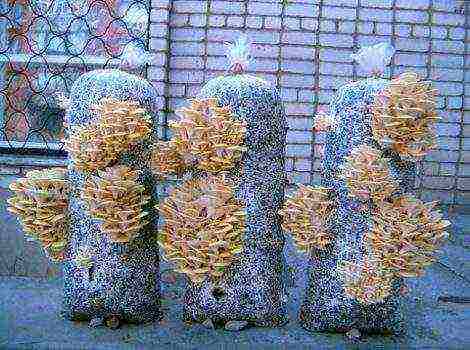Content
- 1 Pot requirements for hosts
- 2 Hosta from seeds at home
- 3 Landing hosts in open ground
- 4 Reproduction of hosts by dividing the bush
- 5 How to properly care for a host
- 6 Diseases of hosts
- 7 Hosta after flowering Preparing for winter
- 8 Description of hosts Photo compositions in garden design
- 9 Varieties and types of hosts with photos and names
Other host entries
Hosta is a charming and mysterious Asian woman. For more than a decade, she has been decorating the shady corners of our gardens, rightfully earning the title of "queen" of the shade. Its bell-shaped flowers are rather modest, but the main advantage of the hosta is not they, but the leaves: ...
What is the best way to combine hosts when disembarking?
Now it is difficult to imagine how you can do without a host in the garden. But some 10-15 years ago, few of us guessed about their huge variety. In culture, there were only a few species and natural forms. Host Twist ...
In the fall, I planted 3 hosts. I mulched it with sawdust. They started to grow a little, as the autumn was long and warm. In the spring I removed the sawdust. The kidneys are still not visible. Maybe it's too early and I'm worrying in vain?
How to make a proper and beautiful hostary?
Tell me the names of the varieties of the tallest host
See all materials
about hosts :
See all
Several years ago I decided to plant a hosta in a pot. I really liked its leaves, I did not hope for flowering. The first year a gorgeous bush has grown and even bloomed!
In the following years, the leaves became smaller and smaller, and there were no more flowers. This spring I wanted to give the host to a friend in the front garden (I live in an apartment), but circumstances interfered, and the plant remained on the windowsill, only the soil was completely changed. The leaves came out in the spring, but smallish.
And what was my surprise when today I discovered FLOWERS! Just beautiful!
Residents of SM, and any of you raised the host at home? Share your experience of care, pliz!

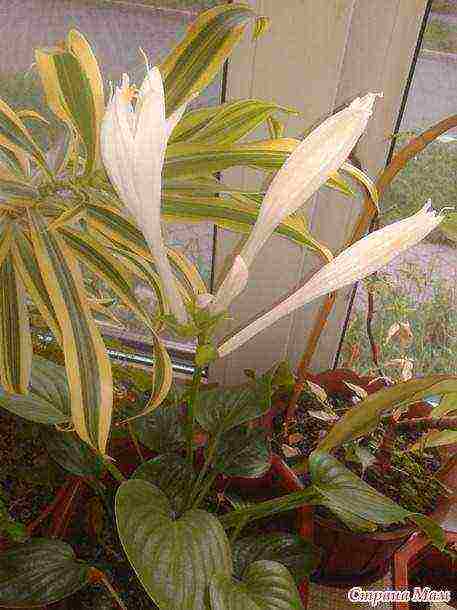
P.S. On the left is Dracaena.
There are a number of hosts that are not recommended to be planted immediately in the ground, where at first they will feel oppressed and may be the victim of malicious snails or slugs, which adore their delicate and thin leaves.

Until hosts form a fairly dense bush, they are best grown in plastic containers (pots).
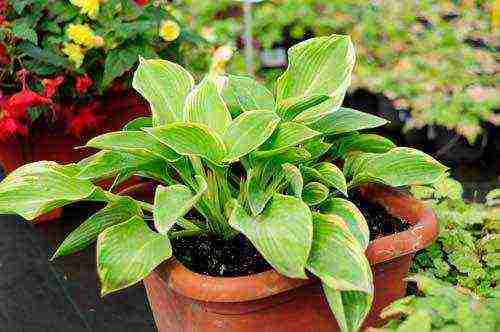
Florists recommend placing a layer of rotted manure on the bottom of the container (pot) on top of the drainage in order to provide the plant with additional nutrition. To avoid excess evaporation of moisture, the surface layer of the earth must be mulched.
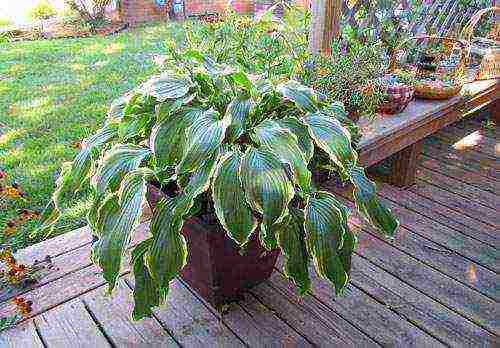
The advantage of container growing hosts is that the plant can be rearranged not only horizontally, but also decorate the resting places with tiers, for example, inside the gazebo, where there is not enough light. The potted host is decorative throughout the season and does not require replacement with other plants.

Requirements for pots for hosts
Hosta pots should hold the right amount of soil and fit the size of the plants. Also important are holes for water drainage, as well as drainage. Young plants are first planted in small containers; as they grow, they must be transplanted into larger pots over time.
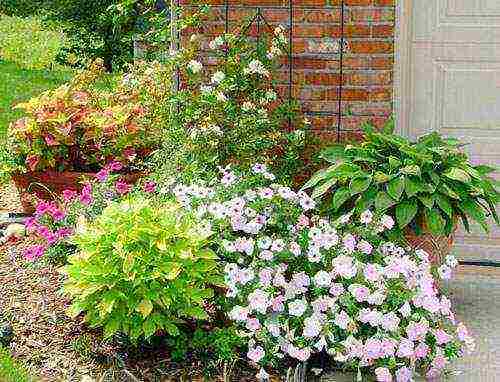
The host in the container needs frequent watering and feeding, since the nutrients are washed out with water.
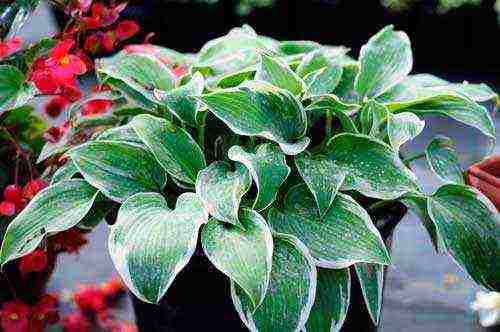
It is very important to place the hosts so that the sun does not warm the pots.Otherwise, the roots that have reached the walls will get burned. Of course, it is best to bury them in the ground.
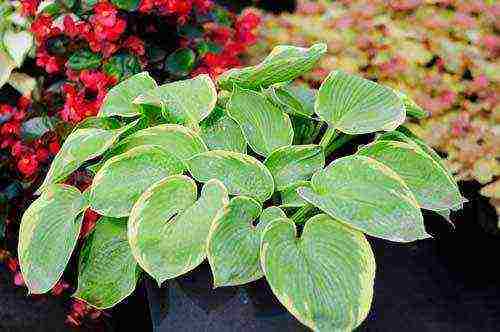
In winter, containers with hosta should not be left outdoors, the plant may rot or freeze out. The hosta pot must be brought into a dry, cool room.
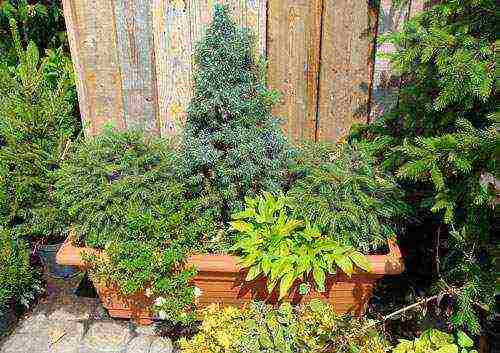
It would be nice to check the condition of the soil once a month, because its drying out is very destructive. For hosts - you need timely, light watering.

Such plants wake up much faster in spring than plants overwintering in the open field. And if the hosta has grown, do not rush to take it outside until the frost has passed. During the day they can be outside, but at night they should be returned to the room.


Hosta (Hosta), the second name - Funkiya, belongs to herbaceous perennials. It represents the Asparagus family, although until recently it belonged to the Liliaceae family. The culture owes its first name to the physician and botanist of Austrian origin Nikolaus Hosta, and the second to the German botanist Heinrich Christian Funk.
Scientists have described up to 40 species of this plant. The hosta originates from East Asia. It is very hygrophilous, therefore, in the wild, it is found near streams and along river banks. For the Japanese, this flower is considered sacred, and the stalks are a local delicacy. When the host was brought to England, the inhabitants of Foggy Albion were not impressed by it. The Americans reacted to it in a completely different way, who made it one of the most popular in the New World.
Hosta from seeds at home
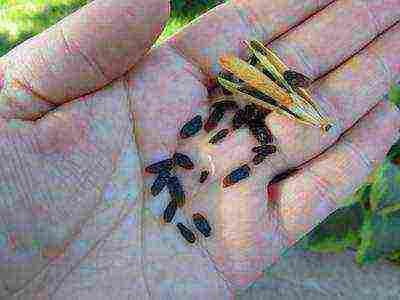
How to propagate hostu Photo of seeds
The host is grown in a garden and flower pot. Regardless of where you will plant the resulting seedlings, it is worth learning the tricks of sowing hosts with seeds. The disadvantage of this method lies in the poor germination of seeds, which is only 70-80%. Therefore, to take advantage of this propagation method, the seeds should be treated with a growth promoter before planting. By placing them for only half an hour in products such as Kornevin, Aloe juice, Zircon or Elin, you can achieve an increase in the percentage of germination.
Among gardeners, there is also the practice of stratification of seeds to increase the percentage of germination, when the seeds are placed in a cold place (for example, the vegetable section of the refrigerator), kept there for 1 month.
An important factor is the sterility of the prepared soil substrate. Various microorganisms, fungi contained in the soil, severely harm seedlings, causing diseases and death of young shoots. That is why it is recommended to purchase the substrate in specialized stores. It contains a balanced mixture of vermiculite, perlite and peat.
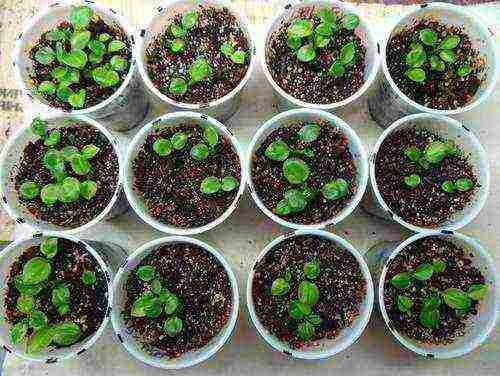
How to grow hosta from seeds Photo of seedlings
When to sow the host for seedlings? In the spring, at the end of February-March, pots are prepared by treating them with medical ethyl alcohol or a weak concentration of potassium permanganate. Drainage is placed at the bottom of the pot, supplemented with a substrate and moistened. Leave for a while so that the soil is well saturated with water, and only then sow the host, as rarely as possible spreading rather large seeds over the surface of the substrate.
The same ready-made substrate is used as a powder on top. Its thickness should not exceed 5-7 mm. To ensure the preservation of moisture, a plastic wrap is stretched over the pot or covered with glass. Make sure that the temperature of the soil at the time of germination is between +18 and 25 ° C.
Compliance with all recommendations allows you to expect the first shoots of a week in two or three. It is important to remember that direct sunlight, excessive watering and excess condensation on plastic wrap are detrimental to plants. It is best to keep the pots indoors with light shade. And only when the first shoots appear, it will be necessary to provide them with good lighting.
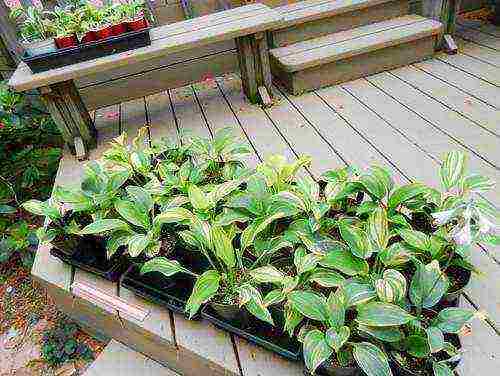
Growing a host from seeds Photo of seedlings
With the formation of the first two true leaves, a pick begins. Seedlings dive into separate pots, the soil in which is a quarter of sand.These pots are placed in a pan filled with water in order to provide bottom watering.
Until the water moistens the top layer of the soil, the pots cannot be removed from the pan. At the next stage, the cut seedlings are hardened. To do this, remove the film and expose the host to the air, the temperature of which should be above +18 ° C. Seedlings with this type of propagation grow slowly and almost always lose the characteristics of the variety.
Landing hosts in open ground
How to choose a landing place for hosts... Choosing a seat is the main thing to pay attention to when landing hosts. Having planted a flower in one place, you can enjoy its beauty for twenty years, even without transplanting. The choice of location is significantly influenced by the color of the hosta leaves. For varieties with bright leaves containing white and yellow blotches, areas that are more illuminated are chosen, since they belong to light-loving plants.
Hosta with variegated leaves is very important that shade falls on it at noon, while in the morning and evening it needs good lighting. As for the blue varieties, they grow only in shaded places and almost do not need the presence of the sun. The size of the flower leaves directly depends on the shade. The more intense the shading, the larger the leaf blade and the higher the bush. But at the same time the host grows very slowly.
The only thing that no flower variety likes is drafts. The soil for planting should be loose, well-drained, nutritious and have a high degree of moisture. Its pH is neutral or slightly acidic.
If the hosta is planted in the spring, then the land is prepared in the fall. For this, the site is covered with a ten centimeter layer of organic matter and dug up. Over the winter, everything will grind and after the spring frosts, somewhere in early or mid-May, it will be possible to plant the plant in the ground.
How to put the host on the video:
Hosta boarding rules
The distance between the holes depends on what type of plant is planted in the ground.
- For hosts from a small and medium-sized group, it is enough to make holes at a distance of 0.3-0.5 m.
- The giants require an increase in distance of up to 0.8-1.0 m.
In order for the transplant to be successful, the seedlings in pots are watered in advance. They move it into the ground along with a lump of earth from the pot. Sprinkle with soil on top and compact it around the plant so that the ground level in this place is a couple of centimeters lower. If the hostas are planted by dividing the bush, then dry leaves and spoiled roots are removed from each cut, adding mulch in the form of crushed bark to the root section.
Reproduction of hosts by dividing the bush

Reproduction of hosts by dividing the bush photo
They begin to divide the hosts after the flowering period or before the start of active growth. To do this, dig in the bush well so that there is enough space around the root. They pry the root from below with a shovel and take out a bush. They are divided into several parts with growth points, the leaves are cut off at a height of 10-15 cm so that only petioles remain, and planted as independent plants. You can leave 2-3 leaves for vegetation control.
Rooting of hosts takes approximately four weeks. The shrubs of the bush in 2-3 years will become full-fledged bushes. They are planted, adhering to the gap between the bushes of 20-30 cm. The pits are made wider during planting, since the growth of the roots is in the horizontal plane. Planting depth is not changed. At the end of the work, the host is thoroughly moistened. Planting is finished no later than mid-September so that the autumn cold does not interfere with the rooting of the transplanted plants.
How to share the host, look at the video:
How to properly care for a host
Garden maintenance work is kept to a minimum. If during planting all the rules for preparing the soil were observed, then for the first three to four years the host can not be fed at all. In subsequent years, humus or compost is applied every autumn under the bushes. Mineral granules can be sprinkled once a season over the area after rain. Until mid-summer, liquid fertilizers are applied under each bush.
A longer feeding time leads to the growth of hosta leaves, and not to preparing it for winter. In the summer, the soil around the hosts is constantly moistened. If the tips of the leaf blade begin to darken, then the plant does not have enough moisture. When watering, do not spray water over the hosta, this will damage the leaves. It is better to water for a long time in the early morning. Direct a quiet jet at the root.
To make the bush look attractive and not fall apart, remove the peduncles in time. The hosta needs to loosen the earth and weed from weeds only in the first period, until it gets stronger and grows. The flower is separated every 3-4 years. To do this, they dig it up and separate the young cuttings from the root so that the flower does not grow much.
Diseases of hosts
Americans associate the occurrence of diseases in hosts with a large number of varieties in one area. In frostbitten bushes, a fungal disease phyllosticosis often occurs, which looks like brown-yellow spots on the leaf blade.
Peduncles are threatened by fungal infection Phyllosticta aspidistrae Oud... To combat it, one method is used: complete removal of the bush, followed by its burning and disinfection of the soil.
Among the diseases are gray rot - Botrys cinerea, which affects the leaves, and sclerotinia - Sclerotinia, which envelops the root collar.like cottony white mold and destroys it. Fungicides are used against gray rot, Dichloran is used against sclerotinia. The main pests of the flower.
Slug is one of the main pests of hosts... Traces of its vital activity, and these are holes in the leaves, become visible immediately and reduce the visual attractiveness of the plant. To combat this pest, small flat containers are used, into which beer is poured. Slugs love these places, where they are collected and then destroyed.
The host can be infected by stem nematodes... If spreading yellow necrotic spots, which are the product of the vital activity of these parasites, are visible through the veins of the leaf, then a simple test will help to detect them. The crushed leaves of the affected hosta are placed in a glass of water and they look, if after 1/2 hour floating worms appear in the water, then the disease is obvious. They remove not only the affected plant, but also all the bushes in the area of two meters, because it is possible to fight against a nematode with chemicals, but it is very difficult to deal with laid eggs.
With the advent of a new vegetative period, larvae will hatch from the eggs and the radius of damage to plants will increase. The invasion of insects such as caterpillars and grasshoppers cannot be avoided, for which one night is enough to turn a healthy plant into an unsightly bush. Only pesticide treatment can help cope with this scourge.
Hosta after flowering Preparing for winter
If the peduncles were left, then after flowering, the hosts remove them. At the very beginning of autumn, they begin to prepare the plant for winter. To do this, the site with the hosta is abundantly moistened, the bushes that have grown over the summer are dug out and divided, leaving one or several rosettes of leaves on each part.
To insulate a plot of land with hosts for the winter, they mulch it with leafy soil. This primarily applies to those flowers that grow under large trees. This action solves several tasks at once, such as warming the host and feeding it. Mulching helps to raise the level of the flower garden, which has a positive effect on soil drainage.
Description of hosts Photo compositions in garden design
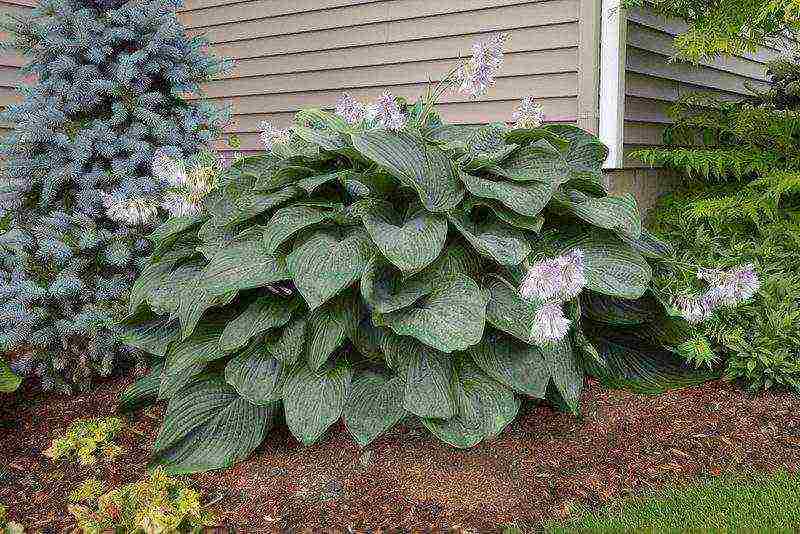
Host in landscape design photo
Hosta serves as a wonderful backdrop for other flowers and is able to decorate any garden arrangement. The plant has very remarkable leaves: they are large and, depending on the variety, have an original color.
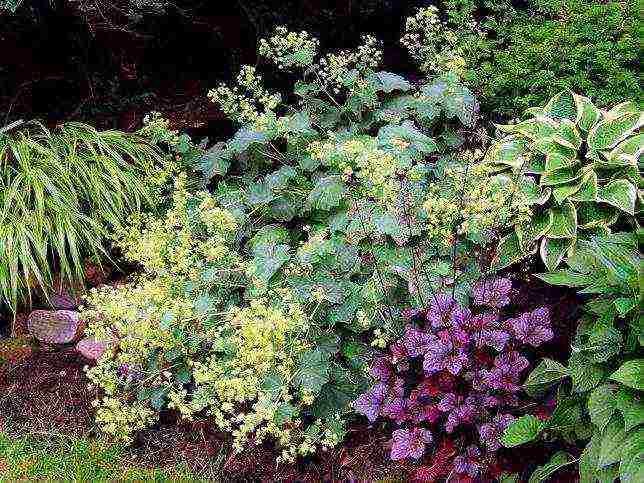
What flowers are combined with the hosts of Heucher and the host of the photo mixborder
It grows very quickly, forms whole plantations and after four years of growth reaches the peak of its attractiveness. Absolutely all types of culture do not have a stem and have a herbaceous structure.

Hosts in garden design photo Combination of hosts hydrangea garden balsam in a flower bed
Its rhizome is compactly thickened and has many branches in the form of laces, which allow the plant to hold firmly in the ground.
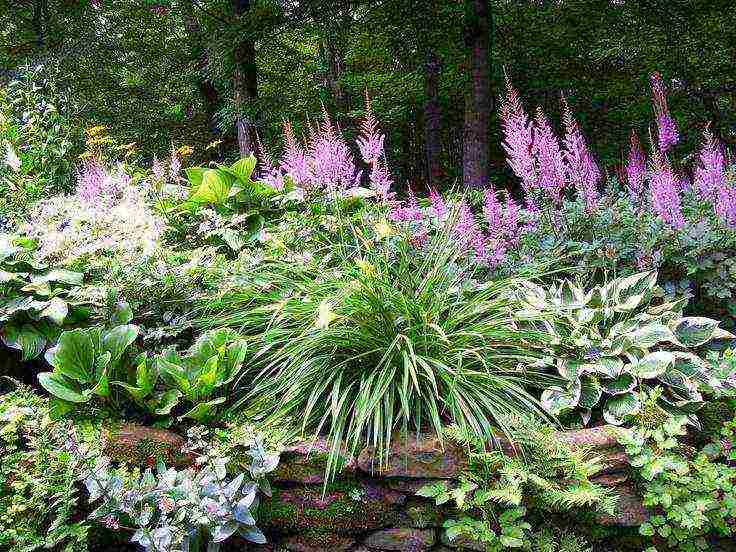
Hosta flowers photo in the garden Combination with astilba
On a long, non-leafed peduncle, which rises high above the rosette of leaves, there are flowers collected in neat brushes. They can be white, bluish, pink, purple, plain or terry.

What colors do the hosts combine with? Hosta buzulnik hydrangea actinidia
Usually, the flowers of shade-loving plants do not have external attractiveness, but with hosta flowers, everything is exactly the opposite. They are truly beautiful, collected in one-sided racemose inflorescences and have a funnel-bell-shaped or funnel-shaped appearance.

Hosts in garden design landscape tricks Hosta combined with hydrangea photo
The fruit is a leathery triangular capsule containing numerous seeds. The main advantage of the plant is its leaves. They are basal, lanceolate or heart-shaped, smoothly turning into a sharp point at the tip of the leaf.

Garden design by hosts Hosts in the garden photo composition
Veins are clearly visible along its entire length. The color of the leaves deserves a separate topic of discussion. It fully depends on the variety, varies and can be with a shade of green, white, yellow and even blue.
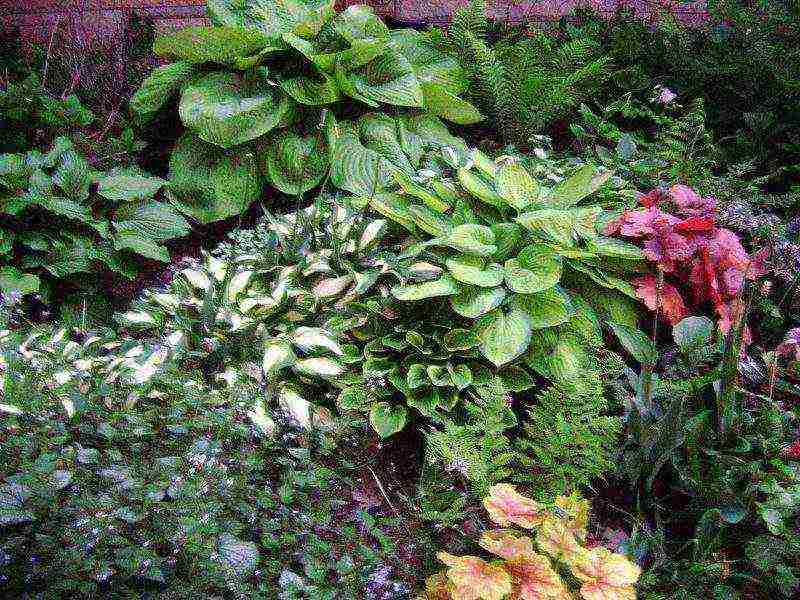
Hosts in garden design with what colors to combine Hosts of mukdeniya karasuba fern tenacious ayuga
Several colors can be combined on one sheet in the form of spots, strokes, stripes. In texture, the leaves can be crinkled and waxy, glossy and matte, with a metallic sheen and simply wrinkled.
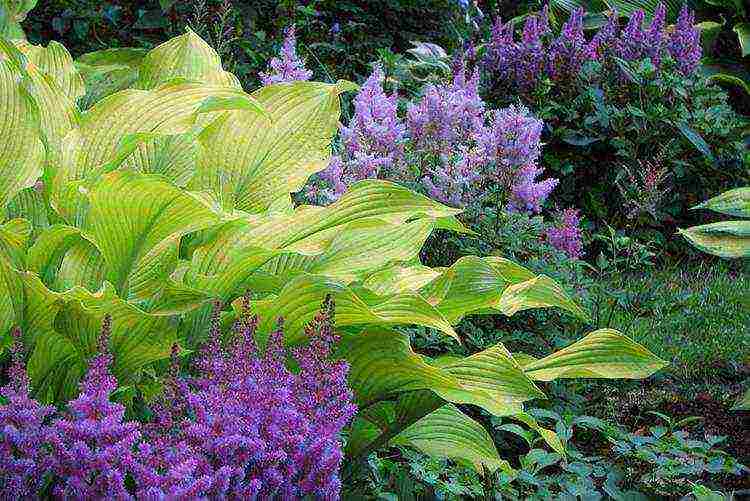
Hosta and astilba in landscape design photo
What is the size of the host?
The average height of the hosts is 55 - 80 cm, although dwarfs, up to 15 cm in height, and giants, which reach 1.2 meters, are also cultivated.
Varieties and types of hosts with photos and names
Let's briefly present the host varieties with photos and names. The culture is widely used in the design of the landscape area, due to the variety of species. The breeding work has borne fruit. Now there are more than 4 thousand hybrid hosta varieties. Several species were taken as a basis, which laid the foundation for varietal diversity.
Bloated host Hosta ventricosa

Bloated Hosta Ventricosa photo in the garden
Up to 0.5 m high, the leaves are pointed at the end, for example, the Thomas Hogg variety.
Wavy host Hosta undulata

Hosta undulata wavy in landscape design photo
Reaches 75 cm in height, its leaf blade has a wavy edge, a white center and a green border, as if applied by strokes. An example is the host Undulata Mediovariegata.
High Hosta Hosta elata Hylanger
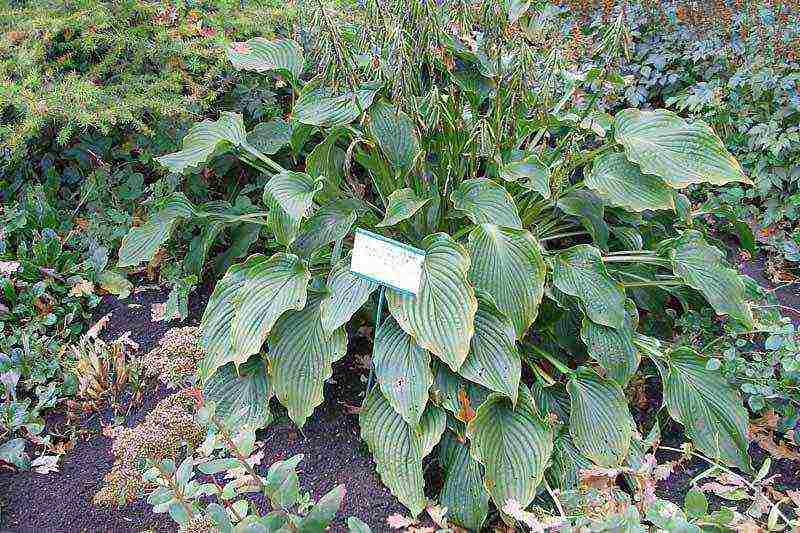
High Hosta Nosta elata Hylanger photo
It grows up to 0.9-1 meter, its rather large glossy leaves cast a dark green color. A typical representative is the Tom Schmid cultivar.
Hosta Siebold Hosta sieboldiana
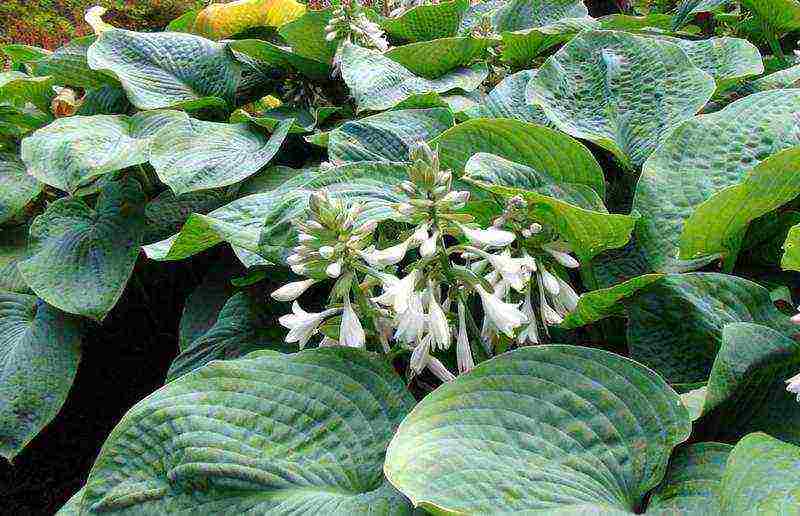
Hosta Siebold Hosta sieboldiana variety Elegans photo
60 centimeters high, has deep veins. Elegans variety.
Curly Hosta Hosta crispula
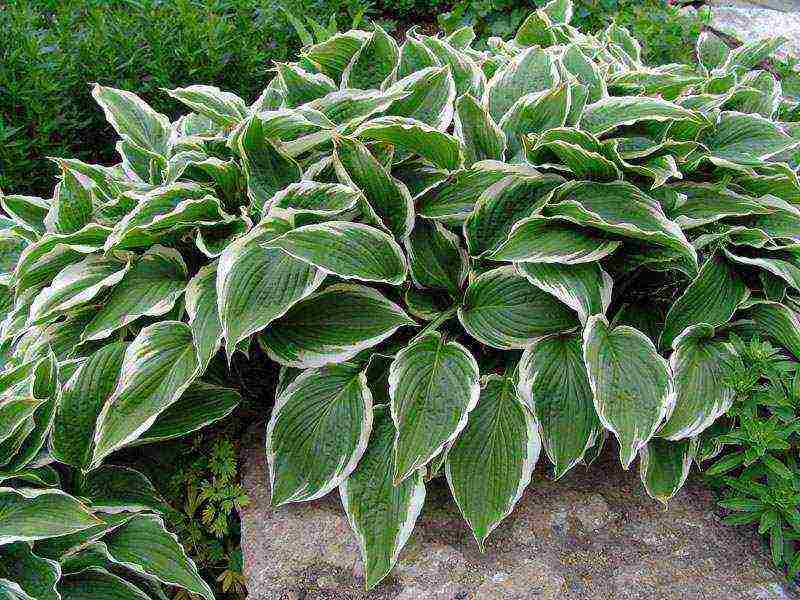
Curled hosta Hosta crispula cultivar 'Thomas-Hoog' photo
Rarely exceeds 0.5-0.6 m in height, with wide dark green leaves bordered by a white stripe. An example is the Dream Weaver cultivar.
Plantain hosta Hosta plantaginea

Plantain hosta Hosta plantaginea photo
Half a meter in height, has bright glossy green leaves. Royal Standard grade.
Hosta fortunei
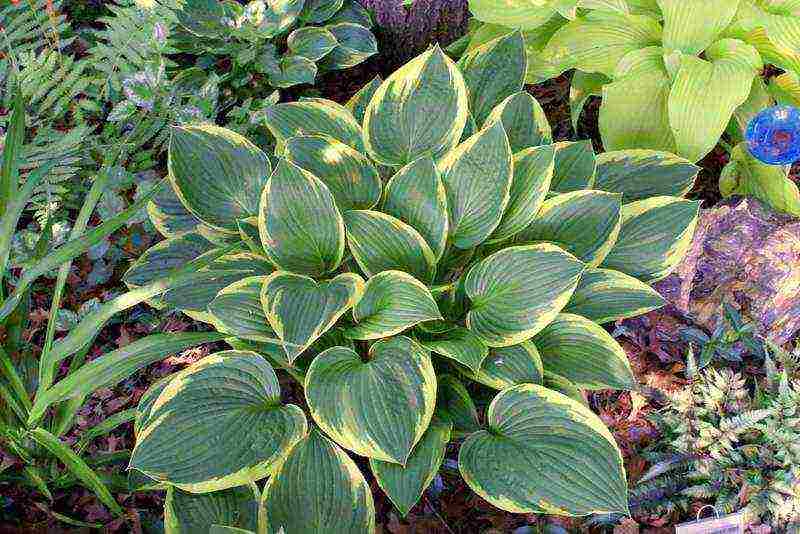
Hosta Fortunei Hosta ‘Fortunei Aureomarginata’ photo
Also, it does not grow more than 0.5 meters, it has green leaves with a cream edging. For example, the host variety albopict.
The classification of varieties is also based on:
- color of the sheet;
- sheet size.
Depending on the color of the leaf plate, the varieties are conventionally divided into 5 groups:
- Blue hosta (blue hosta (B)) - its leaves with a bluish-gray tint.
- Yellow host (Go) - yellow-leaved.
- Green Host (Gr) - Combined all green-leaved host.
- Hosta variegata (V) - varieties with variegated leaves and all those that have a white border.
- Hosta media variety (MV) - light-leaved varieties with a green border around the edge.
By plant height (size), the division goes into the following 6 groups:
- Dwarf group Draft (D), unites all species below 10 cm, such as Blue Mouse Ears with bluish leaves resembling mouse ears.
- Hosta is miniature, Miniature (Mini), its height is within 10-15 cm, for example, La Donna variety with bluish-yellow-green leaves.
- Small Hosta Small (S) with a maximum height of 16-25 cm, examples are Gold Tone with green leaves and stripes of white or yellow, and Headsmen Blue with bluish green leaves.
- Medium hosta Medium (M, Med), growing up to 30-50 cm in height, its representatives are the following varieties: Night Before Christmas, with a white center and a dark green wide stripe along the edge, So Sweet, its green leaves are bordered white and cream stripe, White Feather is a unique host of white color, which changes its color to green after a certain amount of time.
- A group of large hosts Large (L), reaching a height of 0.5-0.7 m, is represented by varieties: Alvatine Taylor, in which a yellow-green border runs along its bluish-green leaves, Golden Meadows with crushed rounded golden leaves in the middle, dotted with pale green strokes and bordered by a wide green stripe.
- Giant hosts Giant (G), over 70 cm tall, for example, Blue Vision with greenish-bluish leaves and Sum of All, which has a green center of the leaf and a wide, golden border.


